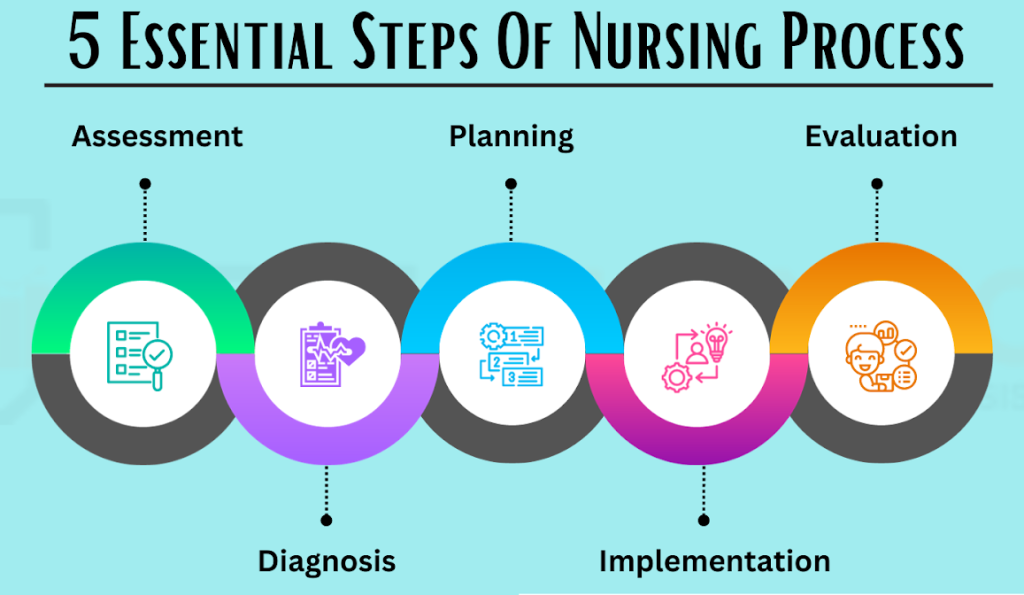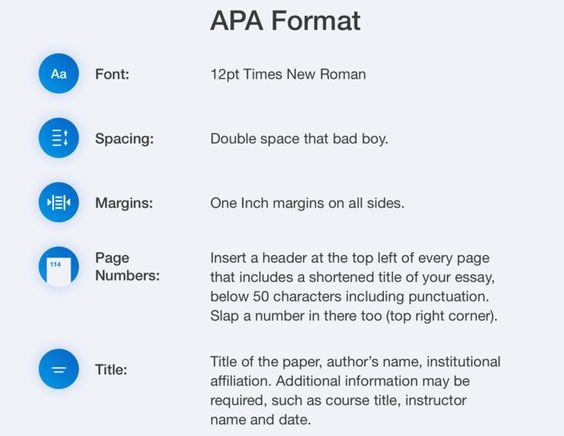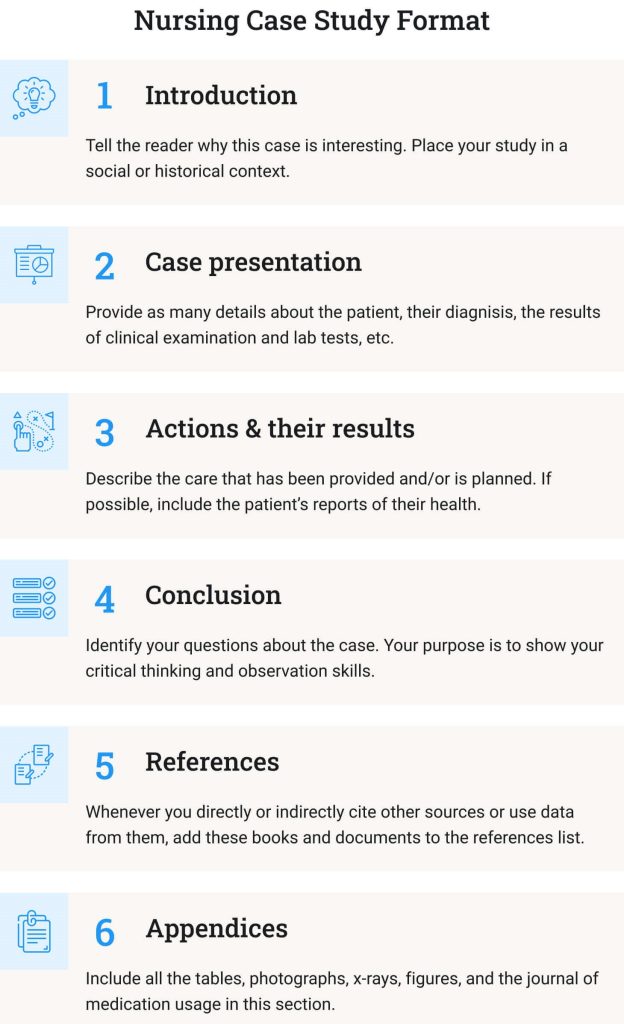
Table of Contents
Nursing case studies are powerful tools for learning and critical thinking. They provide a window into real-life patient scenarios, allowing students and professionals to analyze complex situations, apply theoretical knowledge, and develop essential clinical reasoning skills. A well-written nursing case study in APA format not only presents a compelling patient narrative but also demonstrates a deep understanding of the nursing process, relevant medical conditions, and evidence-based practice.
This article explores effective strategies for writing an engaging and informative nursing case study in APA format.

Steps for Crafting a Nursing Case Study in APA Format
1. Choosing a Compelling Case:
The foundation of a successful nursing case study in APA format lies in selecting a relevant and captivating scenario. The case should be complex enough to warrant analysis and diverse enough to offer opportunities for critical thinking.
- Real-Life Scenarios: Drawing inspiration from actual patient encounters adds authenticity and relevance. Seek permission from patients and protect their identities by using pseudonyms.
- Focus on Specific Issues: Choose a case that highlights a particular nursing challenge, such as managing a complex medical condition, addressing ethical dilemmas, or navigating cultural differences.
- Patient-Centered Approach: The case should center around the patient’s experience, emphasizing their unique needs, perspectives, and preferences.
2. Developing a Clear and Concise Narrative:
The narrative of the nursing case study in APA format should be clear, concise, and engaging.
- Patient Presentation: Begin with a detailed description of the patient’s demographics, presenting problem, and relevant medical history.
- Chronological Order: Organize the information chronologically to facilitate understanding and analysis.
- Objective Reporting: Present the patient’s information objectively, avoiding personal opinions or judgments.
- Use of Active Voice: Employ active voice to enhance clarity and readability.
- Visual Aids: Consider incorporating visuals like charts, graphs, or diagrams to illustrate key concepts and facilitate understanding.
3. Integrating the Nursing Process:
The nursing process, including assessment, diagnosis, planning, implementation, and evaluation, provides a structured framework for analyzing the nursing case study in APA format.

- Comprehensive Assessment: Thoroughly assess the patient’s physical, psychological, social, and spiritual needs.
- Nursing Diagnoses: Identify relevant nursing diagnoses based on the patient’s needs and the clinical situation.
- Planning Interventions: Develop realistic and individualized care plans tailored to the patient’s specific needs and diagnoses.
- Implementation and Evaluation: Describe the implementation of nursing interventions, monitor the patient’s response, and evaluate the effectiveness of the care plan.
4. Utilizing Evidence-Based Practice:
Demonstrate a strong understanding of evidence-based practice by incorporating current research and clinical guidelines into the nursing case study in APA format.
- Literature Review: Conduct a thorough literature search to identify relevant research articles, clinical guidelines, and best practices.
- Rationale for Interventions: Justify the chosen nursing interventions with evidence-based findings and rationale.
- Critical Analysis: Critically analyze the evidence, considering its strengths, limitations, and applicability to the case.
5. Addressing Ethical Considerations:
Ethical dilemmas often arise in clinical practice. Incorporating ethical considerations into the nursing case study in APA format demonstrates a commitment to ethical nursing practice.
- Identifying Ethical Issues: Identify and analyze any ethical issues present in the case.
- Ethical Principles: Apply ethical principles, such as autonomy, beneficence, non-maleficence, and justice, to address the ethical concerns.
- Ethical Decision-Making: Describe the process of ethical decision-making, considering various perspectives and potential consequences.
6. Enhancing Engagement with Interactive Elements:
Interactive elements can enhance engagement and facilitate active learning for readers of the nursing case study in APA format.
- Discussion Questions: Include thought-provoking discussion questions to encourage critical thinking and stimulate debate.
- Scenario Variations: Present alternative scenarios or potential complications to challenge readers’ decision-making abilities.
- Case Studies Within Case Studies: Nest smaller case studies within the larger narrative to explore specific clinical interventions or ethical issues.
- Role-Playing Activities: Encourage readers to role-play different perspectives, such as the patient, the nurse, or the family member.
7. Utilizing APA Formatting Guidelines:
The American Psychological Association (APA) formatting guidelines ensure clarity, consistency, and professionalism in nursing case studies. Here are some basic guidelines for a nursing case study in APA format.
- Title Page: Include a title page with the title of the case study, author’s name, and institutional affiliation.
- Abstract: Provide a concise summary of the case, the key findings, and the conclusions.
- Heading Levels: Use consistent heading levels to organize the information and enhance readability.
- References: List all cited sources using APA style and format.
- Margins, Font, and Spacing: Follow APA guidelines for margins, font type and size, and line spacing.

8. Writing a Clear and Concise Conclusion:
The conclusion of the nursing case study in APA format should summarize the key findings, highlight the lessons learned, and offer recommendations for future practice.
- Recap of the Case: Briefly reiterate the major points of the case.
- Application of the Nursing Process: Discuss how the nursing process was applied to the case and the effectiveness of the interventions.
- Recommendations for Practice: Provide practical recommendations based on the case and the available evidence.
- Limitations and Future Research: Acknowledge any limitations of the case study and suggest areas for future research.
9. Refinements and Polishing:
After completing the nursing case study in APA format, take the time to refine and polish the final product.
- Proofreading: Thoroughly proofread the case study for grammar, spelling, and punctuation errors.
- Peer Review: Ask a colleague or mentor to review the case study for clarity, accuracy, and objectivity.
- APA Style Compliance: Ensure strict adherence to APA formatting guidelines.
Example of a Nursing Case Study in APA Format
Title: A Case Study of Acute Myocardial Infarction: A Patient-Centered Approach
Abstract:
This case study presents a patient, Mrs. Jones, who experienced an acute myocardial infarction (AMI). The case explores the nursing process, relevant interventions, and ethical considerations involved in the care of patients with AMI. The focus is on patient-centered care, emphasizing Mrs. Jones’s preferences and autonomy in decision-making.
Case Presentation:
Mrs. Jones, a 62-year-old female, presents to the emergency department with severe chest pain, radiating to her left arm and jaw. Her medical history is significant for hypertension, hyperlipidemia, and a family history of coronary artery disease. On physical exam, her vital signs are: BP 180/100 mmHg, HR 110 bpm, RR 22 breaths per minute, O2 saturation 90%. An electrocardiogram (ECG) reveals ST-segment elevation consistent with an AMI.
Nursing Process:
- Assessment: Mrs. Jones is assessed for pain level, respiratory status, cardiovascular stability, and psychological distress.
- Diagnosis: The primary nursing diagnosis is Acute Pain related to myocardial ischemia, evidenced by chest pain, diaphoresis, and anxiety. Other nursing diagnoses include Ineffective Cardiac Tissue Perfusion and Risk for Anxiety.
- Planning: The nursing care plan includes interventions such as pain management, oxygen therapy, monitoring vital signs, and providing emotional support.
- Implementation: Mrs. Jones receives morphine sulfate for pain relief, supplemental oxygen, and continuous cardiac monitoring. The nursing staff provides emotional support and educates her about her condition and treatment.
- Evaluation: The nursing interventions are evaluated based on the patient’s response to treatment, pain levels, vital signs, and anxiety levels.
Evidence-Based Practice:
The care plan is based on evidence-based practice guidelines for AMI, including the use of morphine sulfate, oxygen therapy, and aspirin. (Citation of relevant research articles)
Ethical Considerations:
This case raises ethical issues regarding informed consent and patient autonomy. Mrs. Jones is informed about the risks and benefits of treatment options, and her wishes are respected in the decision-making process.
Conclusion:
This case study demonstrates the importance of patient-centered care and the application of evidence-based practice in the management of AMI. Effective communication, pain management, and psychosocial support are critical for optimizing patient outcomes.
Discussion Questions:
- What are the key nursing considerations in the care of a patient with AMI?
- How can nurses promote patient autonomy in the decision-making process for AMI treatment?
- What are the ethical implications of withholding or delaying life-saving treatment based on a patient’s wishes?
References:
(List of cited sources in APA format)
Common Pitfalls to Avoid in Writing a Nursing Case Study in APA Format
While a nursing case study in APA format offers a valuable learning tool, several pitfalls can hinder its effectiveness and impact. Here are some common mistakes to avoid:
1. Lack of Focus and Structure:
- Unclear Objective: Without a clear purpose and focus, your nursing case study in APA format can become unorganized and lack direction.
- Insufficient Detail: Providing too little information about the patient’s condition, interventions, or outcomes makes it difficult for readers to engage and analyze the case.
- Poor Organization: A disorganized presentation makes the case study difficult to follow and understand, even if the information is accurate.
2. Misrepresenting the Nursing Process:
- Oversimplification: The nursing process is a complex framework that requires thorough and accurate application.
- Ignoring Key Components: Failing to address all stages of the nursing process (assessment, diagnosis, planning, implementation, evaluation) creates an incomplete picture.
- Lack of Critical Thinking: Simply listing nursing interventions without explaining the rationale or evaluating their effectiveness demonstrates a lack of critical thinking.
3. Ignoring Evidence-Based Practice:
- Unsupported Interventions: Claiming interventions are effective without providing supporting evidence weakens the credibility of the case study.
- Outdated Information: Relying on outdated research or clinical guidelines can undermine the relevance and applicability of the case.
- Lack of Critical Appraisal: Failing to critically evaluate the evidence, including its limitations and biases, undermines the rigor of the case study.
4. Ethical Oversights:
- Breaching Confidentiality: Disclosing protected patient information without appropriate consent or anonymization compromises patient privacy.
- Ignoring Ethical Dilemmas: Ignoring ethical considerations present in the case weakens the analysis and fails to demonstrate ethical decision-making skills.
- Lack of Sensitivity: Failing to address cultural, religious, or personal values of the patient can create a biased or insensitive portrayal.

5. APA Format Errors:
- Inconsistent Formatting: Deviation from APA guidelines for formatting, citations, and references can make the case study appear unprofessional and difficult to follow.
- Plagiarism: Presenting someone else’s work as your own is a serious academic offense and undermines the integrity of the case study.
- Poor Proofreading: Typos, grammatical errors, and inconsistencies in language detract from the overall quality and readability of the case study.
6. Ignoring the Reader’s Perspective:
- Lack of Engagement: A dry, technical, or overly academic presentation can disengage readers and limit the learning experience.
- Limited Insights: Failing to provide insights, interpretations, or reflection on the case limits its value as a learning tool.
- Lack of Personalization: Presenting the patient as a generic case rather than an individual with unique needs and experiences can make the case less engaging.
7. Focusing on the “Wrong” Elements:
- Prioritizing Medical Over Nursing: Overemphasizing the medical aspects of the case at the expense of the nursing process can diminish the value of the nursing perspective.
- Ignoring Patient Preferences: Failing to address the patient’s preferences and autonomy in decision-making can portray a paternalistic or overly-clinical approach.
- Missing the “Teachable Moment”: Failing to identify and highlight the key learning points or implications of the case limits its impact on student learning.
Remember:
- Clarity and Conciseness: Write in a clear, concise, and objective style, avoiding jargon or overly technical language.
- Real-World Relevance: Connect the case study to real-world practice and demonstrate its relevance to the nursing profession.
- Critical Thinking: Encourage readers to critically analyze the case, consider different perspectives, and develop their own conclusions.
By avoiding these pitfalls and adhering to the best practices outlined in this article, nurses can create an engaging and compelling nursing case study in APA format that effectively contribute to the learning and professional development of students and practitioners alike.

Crafting a compelling nursing case study in APA format involves careful planning, thoughtful analysis, and a commitment to presenting a realistic and engaging patient experience. By adhering to the strategies outlined above, students and professionals can develop engaging and informative case studies that promote critical thinking, enhance clinical reasoning, and advance the understanding of nursing practice. Remember, the goal is not just to present a clinical scenario but to use the nursing case study in APA format as a catalyst for learning, reflection, and professional growth.
The Best Help with Writing a Nursing Case Study in APA Format
At Nursing Papers, we have highly experienced writers to help you with crafting a compelling nursing case study in APA format, MLA, Chicago format and Harvard format. Our service covers topic suggestion, paper writing, proof reading, editing, and plagiarism check and removal. Besides case studies, we also provide writing assistance for nursing research papers, essays and dissertations.







